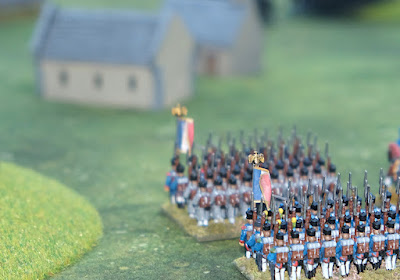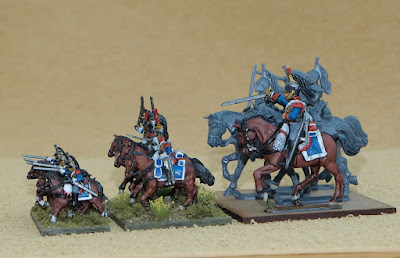Being an advocate of going with a single scale for storage reasons, I find myself, when looking at Napoleonics, of being in the odd situation of having accumulated three different scales in the unpainted stash to choose from.
All have been collected during and since the pandemic and each stock is large enough to easily do the core of a pair of armies. I need to choose one and sell the other two, releasing both space and funds and getting the Napoleonic project at last under way.
Further I would like to settle on a set of rules, but rather like the differing scales, I have a few sets in the front of my queue to choose from.
So, the rest of this post looks at a process of choosing a scale and a ruleset, sticking with it and investing the time and effort it needs to reach fruition. Please use the ‘read more’ tab if this is of interest.
It is not worth me going around the block on how I reached this point, but needless to say, a fickle and butterfly nature has always pulled me in too many competing directions and so, as the Walrus from Alice in Wonderland delightfully mentions - “the time has come to talk of many things”.
What are the three scales? 13.5mm plastic Epic from Warlord Games, 20mm metal from Newline Designs and 28mm (mostly plastic) from Perry and Victrix.
What armies could be built? The Epic would be French / Prussian, while the 20mm and 28mm would both be French / Austrian.
What rules are on the short list? Well, not so short really. Black Powder together with the ‘Eagles’ supplement, Shadow of the Eagles from Keith Flint, Bataille Empire from Hervé Caille, Valour & Fortitude (Jervis Johnson and the Perry’s) or my own Eagles at Quatre Bras set. I do have other rules that I have already decided will not make the cut.
I ultimately see these games having six or so units to start with and then building up to pocket armies of around twelve units, which typically gives games of just two to three brigades per side, so that ‘battle size’ may be one of the stress areas for the rules.
The process of elimination will simply be to set up a generic scenario and play the various scales through with the various rule sets and just see which gives me the right feel and look that best suits what I am after.
Going for a smaller battle will help cycle through the number of games that are needed to complete this task. In any case, the whole ‘pocket army’ concept is to give that smaller, faster game with a smaller collection needed.
 |
| Epic scale with 10mm buildings |
For a scenario, Bataille Empire and Shadow of the Eagles each have an introductory style engagement. There is also a suitable scenario in Neil Thomas’ Napoleonic Wargaming book and whilst I am not sold on the rules, there are several aspects of his ‘method’ that are worth drawing upon.
The Bataille Empire intro has a table with mirrored terrain and forces, so both sides are generically the same and so external factors are neutralised, certainly an interesting concept for test playing. It essentially has a small village in the centre of the table, plus a couple of hills and a couple of woods. The two forces each have 4 line infantry, 1 6pdr foot artillery battery, 2 grenadier, 1 dragoon and 2 light cavalry units, giving 10 units per side and can they can be of any nationality.
The Shadow of the Eagles intro has a table with terrain and forces described that underpins an actual scenario story, so that one army is divided by a river and needs to amalgamate before assaulting the village, the other needs to capture the village and prevent the joining of the enemy army. The village and the bridge each giving victory points (as do casualties). We get good old traditional red and blue armies. One has 9 units and has more cavalry, the other has 10 units and includes 3 light infantry units, so quite different from the mirror approach.
Another alternative, found in Napoleonic Wargaming (by Neil Thomas) simply gives us an exampled AAR (the fictional battle of Liebnitz) and the table offers us a village, a hill and a woods. The game is presented as a French V’s Russian action, but the whole thing about this book is that armies are always 8 units strong and an earlier chapter lists the minimum and maximum unit types that each army can have, so I could refer to these to build our forces according to whether I am putting Prussian (Epic) or Austrians to the table and 8 units is a very respectable starter force for any collector.
Anyway, the point about armies is important, because whichever scenario I choose, already having all of the figures in the various scales, I will make up those small armies to match that scenario in each scale, using MDF bases and raw metal / unpainted plastic figures temporarily mounted on them and use these to game with, while deciding which way to jump. This way I get both a better visual and practical indication of the differences that the scales are delivering and which rules might serve me better.
Once a scale has made the pick, that pairing of armies can be painted up to formally give the initial ‘pocket armies’ - while continuing to play. The various MDF bases needed are winging their way to me at the moment from Warbases (UK).
 |
| An Epic battalion, 2 bases in assault column |
For the Epic scale, I will use 2 x 55mm bases to form an infantry unit (the sets come with their own 60mm bases, but I prefer 55mm to reduce the gap between the stands). The troops come in strips of 10 men, so two of those strips would go on each base, giving a total unit strength of 40 soldiers.
 |
| A 60mm base of 20mm from Newline Designs |
For the 20mm I will be using 60mm bases. Again a pair of bases to represent the unit. The infantry will be in two ranks of 5 per base, so that is 20 men to the battalion.
 |
| Perry 28’s - I can’t decide on whether this 80mm base should have 3 figures in a straight line or … see below |
For the 28mm, I will use the same set-up as the 20’s, but increase the base frontage to 80mm.
 |
| Or whether to go with a boot-to-boot 4 figures, but to make them fit, they are not in a straight line. |
Pairs of bases for a unit work fine to cover most of the Napoleonic formations (including a 2 base gun battery) - although admittedly march column does not translate well and crossing bridges can look a bit awkward.
So if I went with the Bataille Empire scenario for example, an army with 10 units would translate into 20 bases worth of troops. If all those units were infantry, the would translate into 200 figures per army, so no mean task and it is for this reason that initially gaming with unpainted and temporally based figures is a good way to go across the scales.
I do of course have some preferences and pre-conceptions;
I prefer plastic as a material, but do not like having to put together multi part figures, preferring single casts (hello Epic).
I have found that the painting effort between the various scales is not as huge as one might assume. The small scale paint only slightly faster, but there are more of them to do, while the larger figures are easier to paint and so as someone who doesn’t like painting, a bit less tedious (hello 20’s and 28’s).
I like that the smaller terrain allows for ‘more’ battlefield in the same space, so you could have a couple of extra woods and maybe two built up areas rather than one, but I visually like the ‘modelled look’ better on the larger (20mm / 28mm) ancillary terrain such as fences, walls and fields etc (hello all three scales).
I am more pre-disposed to a French / Austrian army than a French / Prussian one … for no particular good reason other than liking the 1809 campaign (hello 20’s and 28’s).
Smaller scale, especially for terrain would be a better storage fit (hello Epic).
So with these sort of things creating a muddle of focus and influencing decisions, actually getting the various figures to the table and just getting the ‘feel’ of them is important, because the overriding factor is likely to be what appeals most on the table - what brings the most joy!
The first jobs then are to pick a scenario, choose an order of battle and wash / prep enough figures to temporarily base them up with a removable adhesive.
Between this and my ongoing Barbarossa boardgame project, I will likely have my hands full for a couple of months. I will pop up some short blog posts on the progress of how things shake out, if and when things look promising enough to comment upon, but there will certainly be some updates anyway over on my Commanders site.
In the meantime there will be other things. I have the boardgame Leningrad going to the table tonight, as part of the Barbarossa Project, likely followed by the siege of Khartoum just for my own fancy (using the same game engine used in Poltava that I reported on recently) and for the figures, we still need to look at how Lord Darcy with respond to the recent Lancastrian incursion at Beacan Farm occurring on New Years Day - he is very annoyed!
Resource Section.
AAR of the Yorkist attack on Beacan Farm. LINK
http://battlefieldswarriors.blogspot.com/2023/01/attack-at-beacan-farm-piggy-longton-1472.html
My sister webspace ‘COMMANDERS’ is being re-configured to showcase various figure and boardgame systems that I am enjoying and gives a flavour of where current projects are up to. Link.



